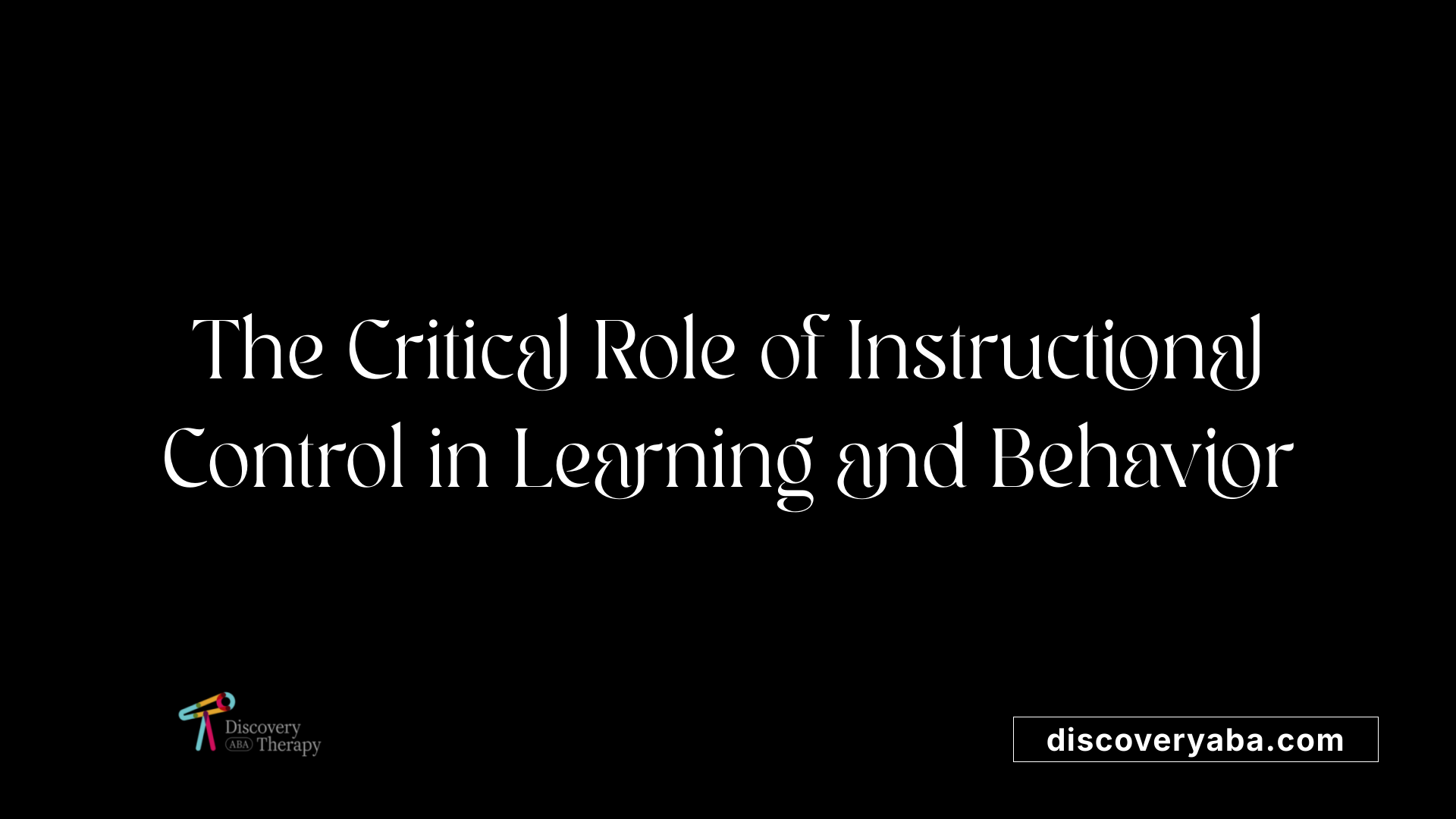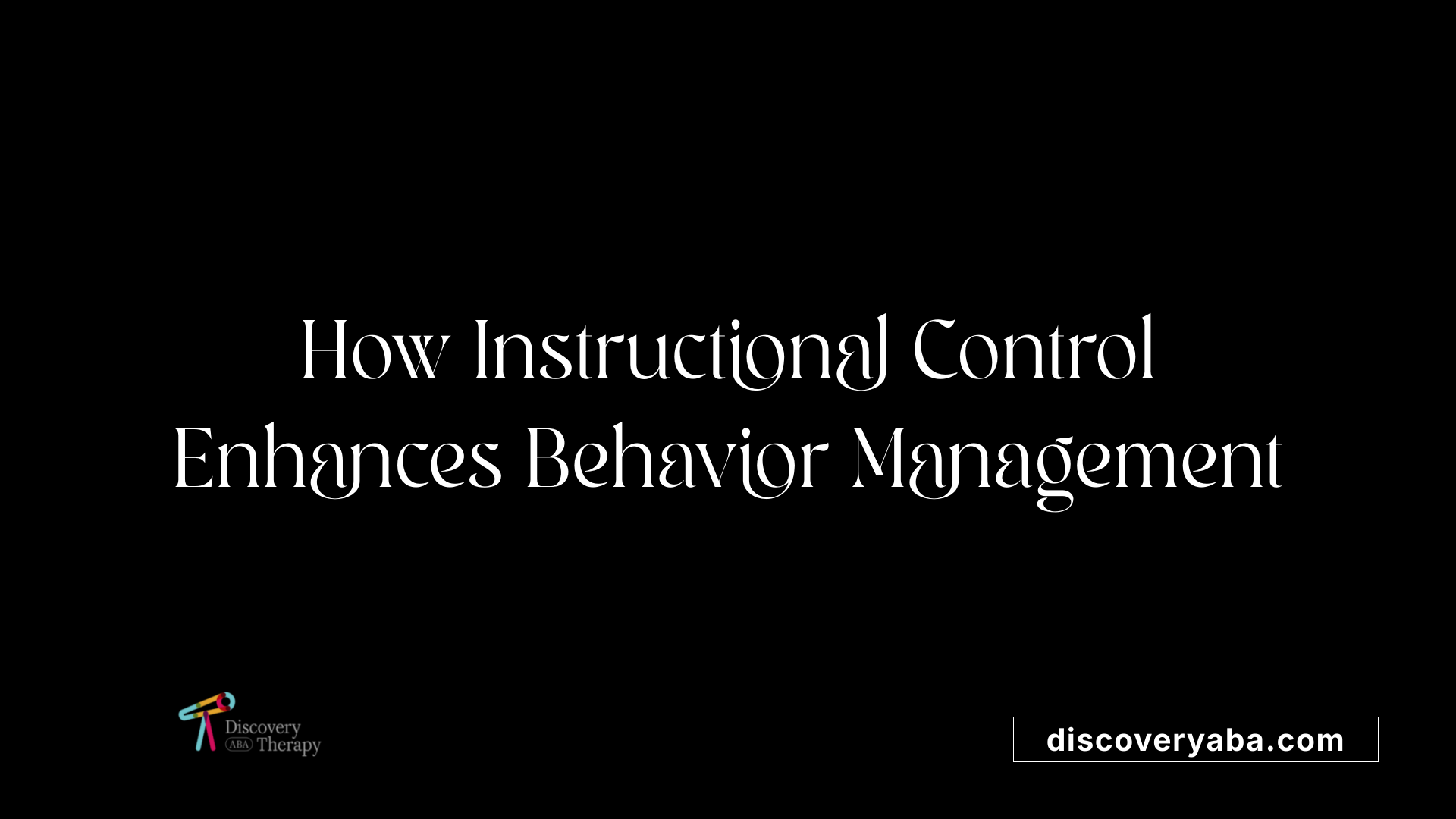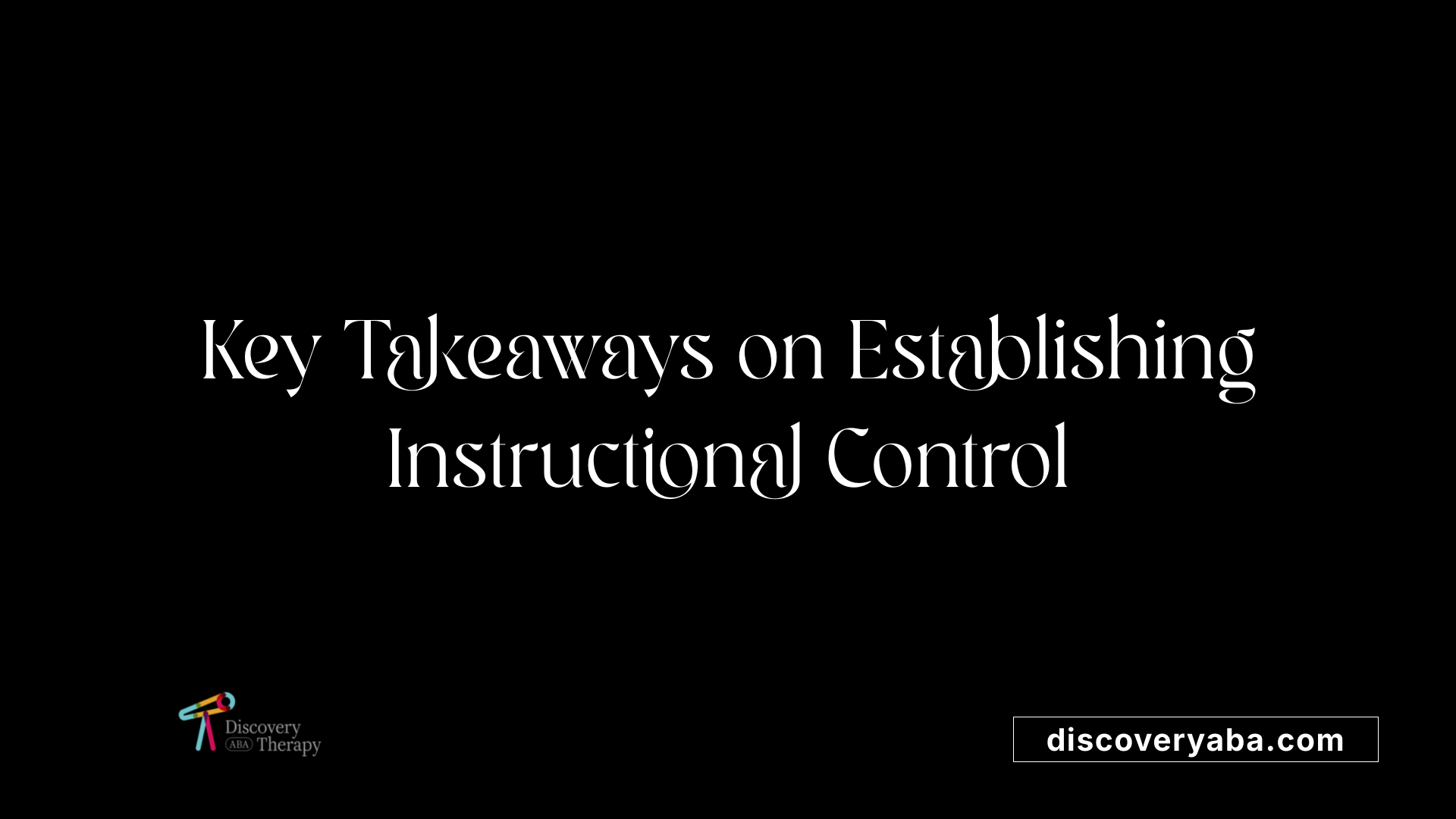What is instructional control and why it matters
Unlocking the Power of Instructional Control in Learning and Behavior

Understanding Instructional Control: The Foundation of Effective Teaching and Behavior Management
Instructional control is a crucial concept in education and behavioral therapy, especially for children with developmental challenges like autism. It refers to the ability of a caregiver or teacher to establish a positive, respectful relationship that encourages the learner to follow directions willingly. This article explores what instructional control is, why it matters, and how it can be effectively established and maintained to foster learning and cooperation.
Defining Instructional Control and Its Core Principles

What is instructional control?
Instructional control in ABA (Applied Behavior Analysis) is the ability of a caregiver, teacher, or therapist to effectively influence a child's behavior so that they willingly follow directions and cooperate during learning activities. It is built through establishing a trusting relationship where the child perceives the adult as a reliable and fair authority.
Initially, this involves pairing the instructor or caregiver with highly motivating reinforcers—things the child values—so that being with the adult becomes desirable. Over time, this pairing helps the child associate the adult with positive experiences and gains.
A significant part of instructional control is consistent, clear communication. Use of straightforward directions like "Push in your chair" is more effective than vague or questioning requests, which can give the child an easy way to refuse. The adult's responses and reinforcement following compliance help strengthen this control.
Strategies such as controlling access to preferred items, offering choices, and providing immediate positive reinforcement for desirable behaviors support instructional control. When the child consistently responds as directed, trust and predictability develop, forming a solid foundation for more complex learning.
The relationship between instructional control and positive working relationships
Building a positive working relationship is fundamental to instructional control. This relationship is based on respect, trust, and understanding that routines and expectations are fair and consistent. When children feel secure and supported, they are more likely to cooperate willingly.
Instructional control is not about dominance but about establishing leadership that is firm yet respectful. Such relationships promote a child's motivation to listen and follow instructions, which is essential for learning new skills and reducing problem behaviors.
Regular routines and consistent expectations across different caregivers help maintain this control. When the child's environment is predictable, and the adult’s expectations are clear, the child feels more secure and willing to engage.
Key components of instructional control: pairing and reinforcement
Two crucial elements of instructional control are pairing and positive reinforcement.
- Pairing involves the adult engaging in enjoyable activities with the child while providing preferred items or activities. This process transforms the adult into a source of positive reinforcement, making the child more receptive to instructions.
- Reinforcement occurs when desired behaviors are followed by positive consequences, such as praise or access to preferred items. Consistent reinforcement encourages the child to repeat those behaviors.
Effective instructional control also includes firm but respectful directives, prompt fading to promote independence, and strategies to handle challenging behaviors without reinforcing tantrums or refusals.
By carefully applying these principles, caregivers can foster an environment where children naturally want to cooperate, making teaching more effective and less stressful for everyone involved.
| Component | Description | Example |
|---|---|---|
| Pairing | Linking the instructor with positive experiences | Playing games together or offering favorite snacks during sessions |
| Reinforcement | Using positive consequences to encourage behavior | Praising the child for sitting calmly |
| Consistency | Maintaining routines and expectations across settings | Same rules applied at home and in therapy |
| Prompting and Fading | Using cues to support responses and gradually reducing prompts | Using gestures initially, then fading to verbal cues |
Why Instructional Control Is Essential in Education and Behavior Therapy

Why is instructional control important in behavioral and educational settings?
Instructional control is fundamental in creating a positive and structured learning environment. It helps establish clear expectations, encouraging children to follow instructions willingly. Building this control involves pairing, which connects the adult and the environment with enjoyable activities, making the learner more receptive to directives.
Maintaining consistent routines and providing reinforcement for positive behavior reinforce the child's understanding that following directions leads to rewarding outcomes. This not only motivates compliance but also fosters trust and a sense of security in the learner.
A solid foundation of instructional control prevents behaviors like bargaining, arguing, or avoidance. Instead, it promotes cooperation and effective communication. When a child perceives the adult as an authoritative yet fair figure, they are more likely to respond reliably to instructions, facilitating teaching of essential skills.
Overall, instructional control is vital as it underpins the ability to teach self-help skills, improve communication, and manage behaviors effectively. Without it, guiding children through routines and learning activities becomes much more challenging, reducing the efficiency of educational and behavioral interventions.
Practical Strategies for Establishing Instructional Control
How can instructional control be established and maintained?
Establishing instructional control requires a carefully planned approach that centers on building a strong, positive relationship with the learner. The process begins with pairing—the foundational step of creating positive associations by engaging in enjoyable activities together, providing access to preferred items, and showing that the instructor or caregiver is fun and trustworthy.
Once the pairing has been established, it is important to set clear, consistent expectations and routines. Using positive reinforcement effectively encourages the child to follow directions and participate willingly. Reinforcers should be powerful and motivating, like favorite toys or activities, and they should be consistently delivered following desired behaviors.
Controlling access to reinforcers plays a critical role. This involves making sure that the child understands they must follow instructions to obtain preferred items. When a demand is made, the instructor should use prompts without bargaining, clearly stating directions (e.g., 'Push in your chair') and providing assistance when necessary. Prompt fading over time helps the child learn to respond independently.
Maintaining instructional control also includes reinforcing compliant behavior immediately and consistently. Responding to non-compliance by not reinforcing avoidance or escape behaviors strengthens the child's understanding that following directions yields positive outcomes. In addition, involving caregivers in consistent routines across settings helps the child respond appropriately everywhere.
Trust is built by following through on instructions and reinforcing appropriate responses regularly. Clear consequences for not following directions, such as withholding access to preferred items, teach the child that compliance is expected and valued.
Overall, cultivating a respectful yet firm relationship, combined with consistent reinforcement strategies and structured routines, creates the environment necessary for effective instruction. This foundation encourages the child to willingly participate and follow instructions, essential for successful learning and behavioral development.
Instructional Control in Autism Interventions
What role does instructional control play in autism intervention and educational contexts?
In autism therapy and educational settings, instructional control is vital for creating a safe, predictable, and engaging learning environment. It refers to the ability of a caregiver or instructor to lead a child's behavior in a positive direction. When instructional control is established, the child is more likely to follow instructions, participate actively in learning, and develop essential skills.
Building this control involves several key strategies. First, pairing the caregiver or teacher with enjoyable activities and reinforcing positive responses helps turn interactions into motivating experiences. The caregiver becomes associated with fun and reward, which encourages the child to seek out those interactions.
Consistent reinforcement is also fundamental. When a child responds correctly to a demand, immediate praise or access to preferred items reinforce the behavior, making it more likely to recur. Using clear, firm, and straightforward directions—rather than vague questions—helps the child understand what is expected.
Another important aspect is graduated prompting—gradually reducing assistance as the child becomes more independent—and withholding reinforcement for non-compliance. This demonstrates that following directions leads to beneficial outcomes, which motivates the child to continue cooperating.
Establishing instructional control can significantly reduce challenging behaviors by replacing avoidance or escape responses with positive engagement. It also facilitates teaching complex skills, including communication, self-help routines, and social interactions.
In summary, instructional control creates a structured yet nurturing environment where children with autism are motivated to participate and learn. It forms the foundation for effective intervention, encouraging cooperation and fostering independence.
| Strategy | Purpose | Result |
|---|---|---|
| Pairing with reinforcers | To make the environment and the caregiver appealing | Increased willingness to engage |
| Consistent reinforcement | To strengthen desired responses | Better compliance and skill acquisition |
| Clear, firm directions | To set expectations clearly | Higher rates of following instructions |
| Graduated prompting and fading | To support independence and reduce dependency | Independent responding increases |
| Withholding reinforcement for non-compliance | To discourage avoidance behaviors | Improved responsiveness |
Overall, instructional control acts as a bridge between the child's motivation and structured learning, shaping behaviors that support lifelong skills.
The Relationship Between Instructional Control and Behavior Management

How does instructional control help in behavior management?
Instructional control plays a crucial role in managing behavior effectively, especially in educational and therapy settings. It establishes a sense of authority and predictability, which helps children understand what is expected of them. When caregivers and teachers develop consistent routines, use clear instructions, and reinforce positive responses, they create a structured environment where inappropriate behaviors are less likely to occur.
A strong instructional control foundation allows adults to respond proactively to challenging behaviors like tantrums or defiance by implementing prepared strategies. For instance, prompt fading—gradually reducing prompts—helps the child learn to perform tasks independently, reducing frustration-driven behaviors. Reinforcing desirable behaviors immediately encourages children to repeat those actions, thereby decreasing instances of undesirable behavior.
Applying extinction techniques, which involve withholding reinforcement for inappropriate responses, is an effective way to diminish escape or avoidance behaviors. When a child attempts to avoid a task, not giving attention or reinforcement for that avoidance helps them learn that cooperation leads to positive outcomes.
Overall, good instructional control facilitates a calm and predictable environment, making it easier to teach appropriate behaviors and manage difficulties. It promotes the learning of new skills, fosters compliance, and leads to more positive interactions between the child and caregiver or teacher.
| Strategy | Purpose | Example |
|---|---|---|
| Consistent routines | Builds predictability and trust | Following the same schedule daily |
| Clear instructions | Sets explicit expectations | Saying, 'Please sit down,' firmly and clearly |
| Positive reinforcement | Encourages desirable behavior | Giving praise or preferred items for correct responses |
| Prompt fading | Promotes independence and reduces dependency | Gradually reducing assistance in tasks |
| Extinction | Eliminates reinforced undesired behaviors | Ignoring tantrums during transitions |
With these strategies, instructional control creates an environment where behaviors are more manageable, and learning is more effective. This firmness combined with warmth helps children feel secure and motivated to cooperate.
Building a Positive and Respectful Relationship for Success

What is the role of trust and rapport in instructional control?
Trust and rapport are fundamental elements that underpin effective instructional control. When a caregiver or teacher consistently follows through on promises and uses positive interactions, the child begins to see the adult as a dependable and authoritative figure. This reliability is crucial, as it encourages the child to follow directions and participate willingly in learning activities.
Creating a sense of trust involves engaging the child in enjoyable, motivating experiences. Demonstrating genuine interest and showing that you value the child's efforts helps foster a positive relationship. This rapport makes children more receptive to instructions because they associate the adult with safety, fairness, and positive outcomes.
Building rapport isn't just about fun; it's about establishing a foundation of understanding and mutual respect. When children feel secure and valued, they are more likely to comply with routines and requests, which are essential components of instructional control.
Consistency across caregivers also plays a vital role. When everyone involved maintains the same approach—using similar language, expectations, and reinforcement strategies—the child perceives a stable and predictable environment. This consistency reinforces trust, minimizes confusion, and encourages the child to respond reliably to guidance.
In summary, trust and rapport are not mere added benefits but core components in establishing a positive, respectful relationship that enables behavioral and learning success. They create the emotional safety needed for children to be motivated to follow instructions and develop essential skills, especially in therapy settings like ABA where aligned strategies are critical.
The Essential Role of Routine and Consistency
How does routine support instructional control?
Routine forms a foundation for successful instructional control because it offers predictability and structure within the learning environment. When routines are established, children develop a sense of security, understanding what to expect during different activities or times of the day. This familiarity encourages them to follow directions more willingly, as they recognize patterned behaviors and associated expectations.
Consistent routines across various settings—home, school, therapy sessions—help reinforce the child's understanding of what behaviors are acceptable and what outcomes to anticipate. This consistency makes compliance easier, reduces feelings of confusion, and diminishes anxiety related to new or unpredictable situations.
When routines incorporate clear steps, such as transitioning from one activity to another or requesting specific responses, and are paired with positive reinforcement, children tend to participate more actively. Using consistent language and cues across settings further strengthens their ability to recognize expected behaviors, facilitating cooperation.
In autism intervention programs, maintaining routine and consistency is especially beneficial. It not only promotes independence but also decreases the likelihood of challenging behaviors. Routine helps children learn new skills systematically, as they rely on established patterns to guide their actions.
Overall, routines serve as a vital strategy in enhancing instructional control and creating an environment conducive to learning and positive behavior.
| Aspect | Description | Importance |
|---|---|---|
| Supporting instructional control | Establishing predictable routines | Builds trust, reduces anxiety |
| Uniform expectations | Consistency across caregivers/environments | Reinforces learning, encourages compliance |
| Routine's influence on compliance | Routine promotes understanding and cooperation | Facilitates learning and independence |
Summary and Final Thoughts on Instructional Control

Recap of Key Points
Instructional control is a foundational element in behavioral therapy, especially in autism intervention, fostering a positive, trusting relationship between the caregiver or teacher and the learner. Establishing this control begins with pairing, where the adult associates themselves with enjoyable activities and rewards, creating a motivated learner ready to cooperate.
Successful instructional control is built through clear, consistent instructions, positive reinforcement, and avoiding arguments or bargaining with the child. Using prompts effectively and providing immediate praise for compliance reinforce desired behaviors and help secure the child's willingness to follow directions.
A vital aspect involves controlling access to reinforcers—preferred items or activities—and making sure routines and expectations are consistent across caregivers and settings. This consistency helps children feel secure and understand what behavior is expected.
Managing challenging behaviors through proactive responses and understanding individual motivators guides effective teaching and promotes cooperation. The ultimate goal is to foster a child’s desire to follow instructions regularly, enhancing learning outcomes and everyday skills.
Why Instructional Control Is Vital for Successful Intervention
Having a strong instructional control ensures that children, particularly those with developmental disabilities, respond reliably to commands. This reliability is crucial for teaching essential skills such as communication, self-help, and social behaviors.
It also increases safety—for instance, when stopping a child from running into danger—because the child is more likely to listen to instructions when instructional control is established.
Furthermore, a good level of control creates a calm, structured environment, reducing behavioral issues and enabling more effective teaching sessions. It allows caregivers to be consistent, patient, and clear, all of which are essential for positive progress.
Without instructional control, efforts to teach or manage behavior become less effective and more stressful for both the child and the caregiver. It makes teaching routines and new skills smoother, helping children reach their full potential.
Encouragement for Implementing Strategies
Building instructional control involves thoughtful planning, patience, and consistency. Start by identifying what motivates the child most—these are your reinforcers—and pair yourself with these positive experiences.
Use clear, firm directions and follow through with prompts when needed, always reinforcing compliance immediately. Establish routines that are the same across settings and caregivers, so children know what to expect.
Remember, avoiding arguments and bargaining keeps your authority respected and your interactions positive. Praising children for following directions reinforces good behavior and builds a sense of trust.
Implementing these strategies consistently over time will help develop a strong, positive relationship with the child, fostering their cooperation and accelerating learning. Be patient—building instructional control is a process, but it is a crucial investment in your child's development and success.
Fostering Effective Learning and Behavior through Instructional Control
In conclusion, instructional control is a fundamental component of teaching, therapy, and behavior management. It creates a safe, predictable environment that motivates children to cooperate and learn. By establishing positive relationships built on trust, pairing, routine, and reinforcement, caregivers and educators can gain and sustain instructional control. This framework enhances the development of essential skills, reduces problem behaviors, and fosters independence. Implementing structured strategies for instructional control not only boosts the effectiveness of interventions, particularly in autism support, but also promotes respectful, trusting interactions that empower learners to reach their full potential.
References
- Instructional Control: 7 Amazing Steps - ABA-Works
- The Importance of Establishing Instructional Control with Your Child
- What is Instructional Control and, Why Do You Need it?
- Who is in Control? Instructional Control In ABA - Blue Bird Day
- [PDF] ESTABLISHING INSTRUCTIONAL CONTROL
- Instructional Control: Do's and Don'ts - Sunny Days Sunshine Center
- [PDF] Compliance & Instructional Control | KidsAbility
- The Seven Steps to Earning Instructional Control with Your Child
Does Your Child Have An Autism Diagnosis?
Learn More About How ABA Therapy Can Help
Find More Articles
Contact us
North Carolina, Nevada, Utah, Virginia
New Hampshire, Maine
Arizona, Colorado, Georgia, New Mexico, Oklahoma, Texas
.avif)




































































































